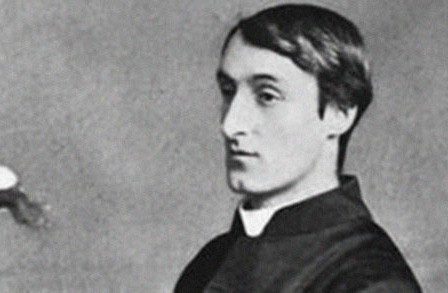I’ve long felt drawn towards both the work and the life of poet Gerard Manley Hopkins (1844–89). The British Hopkins converted to Catholicism in 1866 and joined the Jesuit order of priests in 1868, entering devotedly upon a spiritual path that came to an end with his passing away from typhoid in 1889, after five years of a bleak Church posting to university teaching in Dublin. During his lifetime his poetry was known, by and large, only among his family and a handful of friends—notably future British Poet Laureate Robert Bridges, who saw to its posthumous publication. Every couple of years I find myself once again compelled to revisit Hopkins’s work by my overly Romantic—yet, for me, inescapable—impression of him as passionate poet-priest tragically doomed to die too soon. It makes little difference that such impression of him, no matter how much more titillating than the reality of his life, is ultimately inaccurate and misleading.
Still, I unabashedly pursue my own version of the poet despite his staid Victorian ways, which are manifested in his infamously stolid remark: “I always knew in my heart Walt Whitman’s mind to be more like my own than any other man’s living. As he is a very great scoundrel this is not a pleasant confession. And this also makes me more desirous to read him and more determined I will not.” This admission, made in a letter to Bridges, keeps me committed, always hoping for the “scoundrel” in Hopkins to appear in my reading as I poke around for any snatches of the sort of ribald exuberance I delight in when reading Whitman. Still, it is not at all surprising that Volume III of Hopkins’s collected works—alluringly entitled Diaries, Journals, and Notebooks—presents little in the way of evidence for Hopkins as any sort of “scoundrel.”
Not that the title is intentionally misleading; editor Lesley Higgins describes how “[t]he title of this volume in the Collected Works is not simply ‘diary’ or ‘journal’ because no one term adequately describes the ‘pied,’ incongruous variety of the entries that he made.” After all, even if Hopkins ever wrote anything of implicative nature he assuredly destroyed the manuscript soon after. And of course multiple generations of Hopkins scholars have already judiciously sifted the extant private jottings contained here. Nevertheless, while, as Higgins notes, “the poems were always intended for an audience, however small and varying,” it is the fact that “the journals… were composed for an audience of one—Hopkins—who, like all diarists, was committed to life-writing practices not simply to itemize his daily activities, but to explore the possibilities of textual ‘selving.’” This makes this volume indispensable for accessing evidence of Hopkins’s thoughts and perceptions as close to the site of the personal as possible.
Diaries, Journals, and Notebooks presents a large chunk of Hopkins’s raw inner life: his observations, accounts, and reflections, from early to mid-adulthood. The earliest extant diary entry dates from 1862 and was preserved when an eighteen-year-old Hopkins transcribed a lengthy journal passage concerning his bitterness over a disappointing exchange with a schoolmate into a letter written to another fellow student. Hopkins closes the entry with typical diffident hopefulness, remarking, “Perhaps in my next friendship I may be wiser.” The rest of the contents follow chronologically from his “diaries” of the 1860s up through his “journals” of the1870s, after which nothing is available for several years save for comparably brief entries in his “notebooks” for 1884 and 1885. (Hopkins’s personal writing during his final years is covered separately in volume VII of the Collected Works, The Dublin Notebook.)
Many passages, especially among the earliest entries, have been crossed out by Hopkins. This action has been reproduced in publication while preserving the readability of crossed-out passages. Some of this material is comprised of minor self-reminders, tasks to be completed, appointments, and the like. Yet much of it is also made up of self-recrimination—“inattention at family prayers. Intemperance at dinner”—and oftener than not is sexual, or at least what may be perceived as sexual in nature. There are many instances of his denouncing himself in such fashion: “[O]ld habits. Evil thoughts and various dangers” (“old habits” or “OH” represents masturbation), and indications that he was fearful of being led astray by such impulses even when it was out of his control: “sin in dream perhaps.” There are also occasions where Hopkins is clearly resisting homosexual inclinations: “Imprudent looking at organ boy and other boys” and,“Looking at temptations, esp. at E[dmund] Geldart naked.”
There is also one brief and startling instance when Hopkins allows a glimmering of what he would likely have self-identified with in Whitman’s poetry. This passage may be as close as Hopkins ever allows himself to being “a very great scoundrel”: “Waste of time. Madox Brown’s pictures. Looking at navies in Swiss Cottage Field.” Footnotes identify “navvies” as “construction workers” and indicate that “Madox Brown’s pictures” likely refers to an article in a popular magazine of the time, which included Brown’s sketches of “‘navvies’ digging up the road.” Whitman’s poems are prominently known for exulting in evocative celebration of working men with their brawny bodies in motion. Here Hopkins clearly reveals himself to be similarly tempted by such scenes. It’s also worth noting that Whitman wasn’t the only contemporary poet from across the Atlantic Hopkins found less than deserving of his attention. Elsewhere he notes how he found himself, “Wasting time in looking at [Edgar Allan] Poe’s poems.”
Higgins remarks on how, as a Jesuit, “Hopkins never hesitated in his ardent allegiance to the training of mind and will he experienced.” Indeed, such stringent self-censoring as demonstrated by these crossed out passages signifies a self-denying aspect of Hopkins’s personal demeanor. This was likely an element of his desire to join the priesthood, and particularly as a Jesuit—an order whose organizational structure is derived from hierarchical relationships found in military organizations. In hindsight, it’s sometimes difficult not to read more than a bit of sadomasochism into Hopkins’s inner passions and the ways in which he resisted them.
It is, in the end, the vivid eye Hopkins possesses for noting, with detailed precision, the remarkable in the everyday as witnessed in the natural world—what he referred to as “inscape”—that holds the attention of many readers, including me. Nobody beats Hopkins when it comes to describing a natural landscape of clouds, trees, sunset, sunrise, swirling waters, changing weather, and dangling leaves jostled about by the breeze. Examples are abundant throughout later entries in this volume, in which Hopkins is barely able to mention the day’s weather or an outdoor walk, no matter how briefly, without being carried away into lush description:
Drops of rain hanging on rails etc. seen with only the lower rim lighted like nails (of fingers). Screws of brooks and twines. Soft chalky look with more shadowy middles of the globes of cloud on a night with a moon faint or concealed. Mealy clouds with a not brilliant moon. Blunt buds of ash. Pencil buds of the beech. Lobes of the trees. the eyelids. Pencil of eyelashes. Juices of the eyeball. Eyelids like leaves, petals, caps, tufted hats, handkerchiefs, sleeves, gloves. Also of the bones sleeved in flesh. Juices of sunrise. Joins and veins of the same. Vermillion look of the hand held angst. a candle with the darker parts as the middle of the fingers and esp. the knuckles covered with ash.
The manner in which he loses himself in such scenes is reminiscent of Keats’s concept of negative capability. It’s striking how the otherwise reserved Hopkins suddenly becomes so comfortably caught up, in Keats’s words, “in uncertainties. Mysteries, doubts, without any irritable reaching after fact and reason” in these descriptive passages. When young, Hopkins did for a brief interlude consider pursuing an artistic career, and there are several pages of drawings scattered throughout the entries. None are exceptional or intended as finished works of art, but they add to the accumulating sense of how intensely Hopkins looked and looked again upon shapes and forms in the world. His imagination flowed round rarified detail after detail as he piled up adjectives in a colossal attempt to capture the extraordinary in every encounter. Reading Hopkins’s descriptions, one feels a hint of the tingling that must be but mild measure of what coursed through him at the time. To read his words in Diaries, Journals, and Notebooks is to approach an understanding of the source behind the ecstatic. It is a thrilling embrace of experience.





